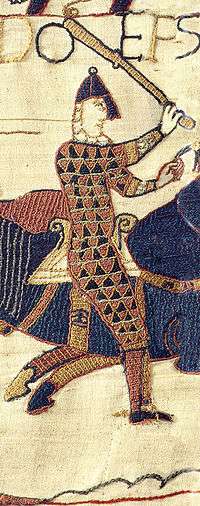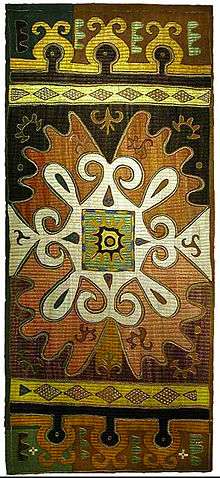Embroidery thread

Embroidery thread, left to right: No. 5 perle cotton (coton perlé), matte cotton embroidery yarn, tapestry wool, cotton stranded embroidery floss
Embroidery thread is yarn that is manufactured or hand-spun specifically for embroidery and other forms of needlework.
Threads for hand embroidery include:[1]
- Crewel yarn is a fine 2-ply yarn of wool or, less often, a wool-like acrylic.
- Embroidery floss or stranded cotton is a loosely twisted, slightly glossy 6-strand thread, usually of cotton but also manufactured in silk, linen, and rayon. Cotton floss is the standard thread for cross-stitch. Extremely shiny rayon floss is characteristic of Brazilian embroidery. Historically, stranded silk embroidery threads were described as sleaved or sleided in the sixteenth century.[2][3]
- Filoselle is a historical term for embroidery floss made using the leftover waste from reeled silk.[4]
- Matte embroidery cotton or French coton à broder is a matte-finish (not glossy) twisted 5-ply thread.
- Medici or broder medici is a fine, light-weight wool thread formerly manufactured by DMC Group.
- Perle cotton, pearl cotton, or French coton perlé is an S-twisted, 2-ply thread with high sheen, sold in five sizes or weights (No. 3, 5, 8, 12 and 16 (Finca), with 3 being the heaviest and 16 the finest).
- Persian yarn is a loosely twisted 3-strand yarn of wool or acrylic, often used for needlepoint.
- Tapestry yarn or tapestry wool is a tightly twisted 4-ply yarn.
Threads for machine embroidery are usually of polyester or rayon (less often cotton or silk).
Threads, like textiles, can contain compounds that may be harmful to humans. Many dyes have been shown to be allergenic and in some cases carcinogenic.[5][6] Testing for the presence of these dyes, and other additives can be done at many commercial laboratories.
Certification to the Oeko-tex standard may also be applied for. This tests the component for over 100 different chemicals and certifies the component according to human ecological safety.
Notes
- ↑ Reader's Digest Complete Guide to Needlework. The Reader's Digest Association, Inc. (March 1992). ISBN 0-89577-059-8, p. 8
- ↑ Shakespeare, William (2006). John Roe, ed. The poems (Updated ed.). Cambridge: Cambridge University Press. p. 275. ISBN 9780521855518.
- ↑ Cumming, Valerie; Cunnington, C.W.; Cunnington, P.E. (2010). The dictionary of fashion history (Rev., updated ed.). Oxford: Berg. p. 271. ISBN 9781847885333.
- ↑ Kerridge, Eric (1988). Textile Manufactures in Early Modern England. Manchester University Press. p. 141. ISBN 0719026326.
- ↑ Crespo et al, Contact Dermatitis, 2009,
- ↑ www.cen.eu
References
- Reader's Digest Complete Guide to Needlework. The Reader's Digest Association, Inc. (March 1992). ISBN 0-89577-059-8
This article is issued from Wikipedia - version of the 11/6/2016. The text is available under the Creative Commons Attribution/Share Alike but additional terms may apply for the media files.


